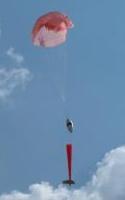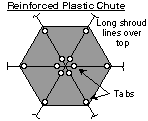| | NARAM-46 | |
| |
| |
| |
| | | | |
| |
Note that for NARAM-46, the Egg Duration event for A Division is C engine class, while for B, C, and Team divisions it is B engine class. In general, models that are good for B Eggloft Duration are also good for C Eggloft Duration. But heavier models will be unable to fly on B engines, and some could even be too heavy for a C. Eggloft Duration combines the challenge of flying a model containing and recovering a Grade A Large egg intact, with trying to stay in the air as long as possible. Sometimes doing too well, staying up so long that the model flies away, unrecoverable, or landing in an inaccessible spot (or tree). The model must stay together, nothing can separate from it other than wadding. It cannot be staged. If the egg is not returned or is damaged (cracked, broken, etc.), the flight is disqualified. You can NOT catch the egglofter, it must be allowed to land naturally. For the full rules for this event, please see the Eggloft Duration Rules on the NAR web page. Scoring - For Eggloft Duration only, the scoring is best SINGLE qualified flight time, returned, of two flights allowed. Design considerations - Balancing ability to store and reliably deploy a large parachute, with low model weight. An all-18mm body with a capsule on top as used for Eggloft altitude is not a good choice here since parachute storage space is very limited. An egglofter with a long tapered conical shroud is a good way to go, as it has a significant amount of parachute storage space. The Two Minute Egg plan is such a model, and both ASP and QCR have similar contest oriented kits. A straight body tube with a larger diameter, such as 1.3" to 1.65" diameter (BT-55, 35mm, BT-60) can be used. The model will be draggier and usually heavier, of course, and therefore at a competitive disadvantage. The Quest "Courier" egglofter kit can be used for C Eggloft, it is too heavy to use for B Eggloft. Some regular models you might already have can be adapted to fly as an eggloft duration model by replacing the nose cone with a capsule. But they cannot be too heavy or they just will not fly safely enough with the added weight of an egg. A list of plans and kits is included further down on this page. Egg Capsule - Pratt Hobbies makes an excellent vac-formed egg capsule (the old CMR capsule). Some companies like ASP and QCR carry that capsule. Apogee also has their own vac-formed egg capsule. Another capsule sometimes used is a plastic Easter Egg, of a size that is just a little bigger than an egg. Using two "long halves" from two 1.75" diameter Easter eggs, rather than one plastic egg due to the short half with a flange sticking out, as the flange limits the inside diameter too much. Easter Egg capsules that small can be hard for the eggs to fit in and be safely cushioned, however. "Grade A Large" eggs tend to vary significantly in diameters, so Easter Egg capsules are somewhat risky, unless you have an Easter Egg that is 2" or so in diameter. Since this is for duration, it's best not to risk using a too-cramped capsule. Padding - Use foam or some other flexible material to try to cushion the egg so it will not get cracked. My favorite basic cushioning is to get hold of a foam egg carton and cut out the four corner "cups", as they fit the egg pretty well. I add other thin foam padding as well. The egg needs to be padded enough that it can't rattle, but don't pack it so tight that it's under pressure loaded in the capsule. If you are using a plastic capsule, don't bother with putting the egg inside of a plastic bag....if the egg breaks you can just clean the capsule with water, without any damage.
Shock Cords - It is useful to use a shock cord that can actually absorb the shock of deployment , given the weight involved with egglofters. 1/8" elastic works very well for that purpose, but is not ideal to attach directly to the body tube. Many competitors prefer to use a length of 100 pound grade Kevlar cord to attach to the body tube (especially for mounting inside), then tie the elastic shock cord to the other end of the Kevlar cord. The 2-Minute Egg plan mentions using wire cable in a similar way to link elastic to the model, that was a method used before Kevlar came into use for contest models, so 100 pound Kevlar can be used rather than wire cable for the 2-Minute Egg.
|
| Model Plans & Kits | Designer | Notes |
| 2-Minute Egg Plans (NAR website) | Plan by George Gassaway | Good competitive plan for B and C power |
| ASP - Egglofter Kits (various) & Pratt Egg Capsules | ASP (Aerospace Specialty Products), Andy Jackson | Good competitive kits for B and C power |
| QCR - Egglofter Kits using "Easter Egg" & "Pratt " capsules for 18mm engines. | QCR - Qualified Competition Rockets, Ken Brown | Good competitive kits for B and C power |
| QUEST - "Courier" sport egglofter kit | QUEST - Model Aerospace Company | Not too competitive, but flyable on a C6-3. Available from Quest dealers, including Red Arrow and Apogee |
| by Andy Jackson, on the ASP website | Great article on considering what size or type of parachutes to use in egglofting competition, whether for duration or altitude. Also tips on chute packing. |

